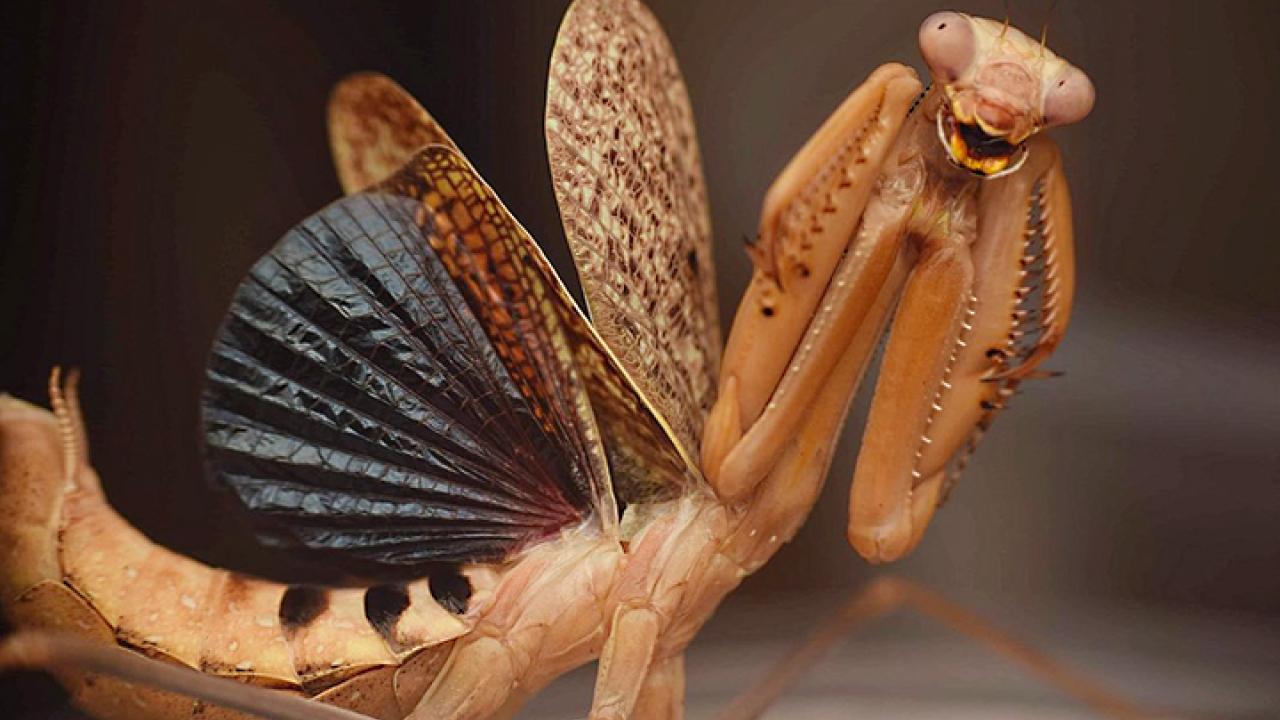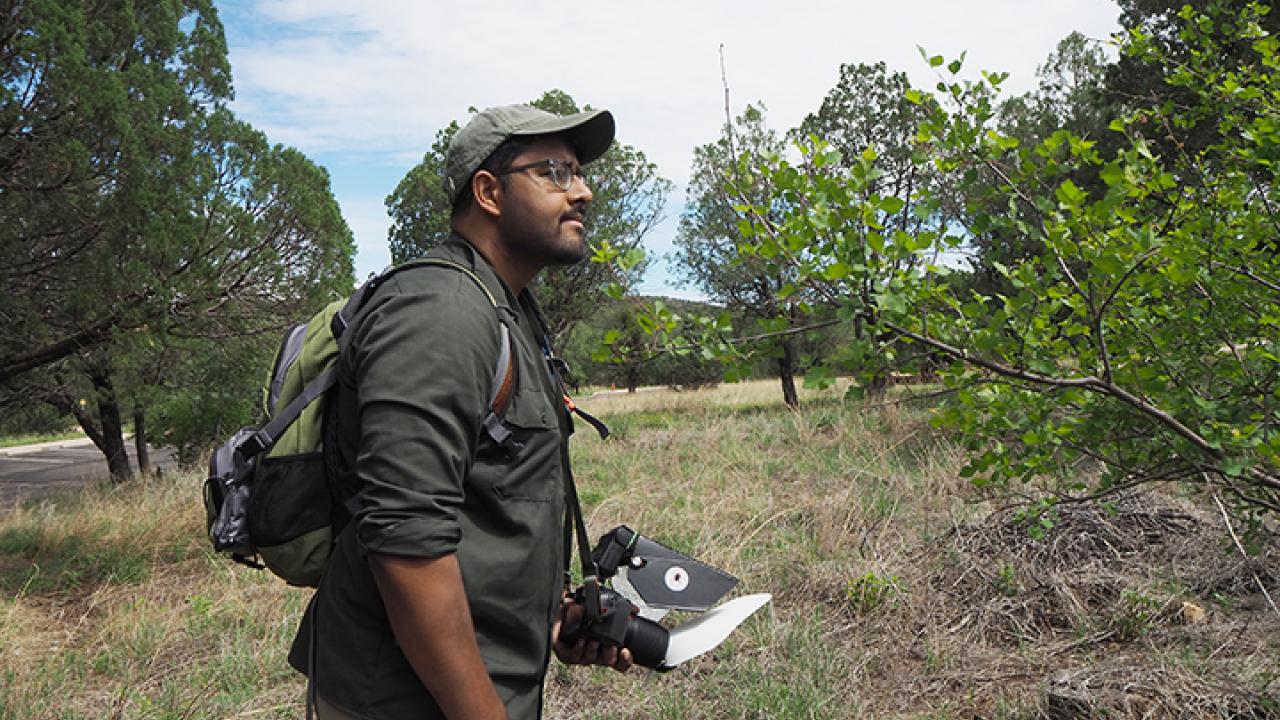
UC Davis Alumnus Discovers New Species of Praying Mantis
Lohit Garikipati Credits Entomologists and Citizen Scientists With Making It Happen

He never expected to discover a new praying mantis species.
But a juvenile mantis that UC Davis alumnus Lohitashwa “Lohit” Garikipati collected on a 2019 trip to Madera Canyon, Arizona, proved not to be the commonly known California mantis, Stagmomantis wheelerii, but a new species.
It all started when Garikipati, now a newly enrolled doctoral student at the Richard Glider Graduate School at the American Museum of Natural History, joined his friends and fellow entomologists to collect specimens on multiple trips to southern Arizona.
“That individual that I collected in 2019 failed to molt to adult,” Garikipati said. “In subsequent years, I went back looking for a similar individual, but with no luck. It wasn’t until Peter Clausen (a citizen scientist in Sonoita, Ariz.) sent me an adult female that I had the inkling it might be a new species.”
Subsequent research, spanning comparative morphology, citizen science contributions, and captive observations, resulted in a mantis researcher’s dream: he’d discovered a new species.

His newly published research, "Description and Total Ontogeny of the Sonoran Tiger Mantis, Stagmomantis clauseni sp. nov., and Key to the Subgenus Nigralora (Mantodea: Mantidae),” appears in Zootaxa at 10.11646/zootaxa.5501.1.4.
He named it Stagmomantis clauseni, in honor of Clausen. Its common name, “Sonoran Tiger Mantis,” refers to its locality, aggressiveness and coloring.
“Peter is one of the founders of hobbyist pages like mantidforum.net that I joined as a kid and learned quite a bit about mantises from other hobbyists around the world,” Garikipati said. “He also continues to participate in research in a citizen science capacity by helping researchers by collecting and documenting specimens from Arizona and surrounding areas.” Clausen is on Instagram at https://www.instagram.com/bugsincyberspace/.
The Sonoran Tiger Mantis is "a really aggressive species and will stalk prey from pretty far away!” Garikipati said. “The tiger portion of its name comes from the pretty active nature of this species, as it tends to move around and forage rather than remaining still for large periods of time, compared to other mantises. When threatened, they will readily hold their ground and flash their bright hindwing coloration and abdominal striping, bare their mandibles, and strike at aggressors.”

The coloring? To be specific, “this species has bright orange/gold on the inner margins of the forecoxa and ventral margin of the propleuron, and has bright black banding along the posterior margin of the first few tergites (dorsal segments) of the abdomen. All those things immediately made me think of a tiger.”
'Pretty Aggressive.' Garikipati further describes S. clauseni as “a low-foliage predator, staying close to the ground in 5 feet or less vegetation. “It’s able to weave within and around tight or dense foliage in the desert and will absolutely chase down prey using its long legs. They’re pretty aggressive, so even insects—and potentially small vertebrates similar or slightly larger in size--would be on the menu!”
Garikipati said the species “tend to lay their oothecae (egg cases) near each other, which is atypical for most mantises. And they usually lay their egg cases under rocks.”
With Garikipati’s discovery, there are now 28 described native species of mantises in the United States. “And more are likely,” he points out. “There has not yet been a comprehensive genomic or even genital comparison of mantises in the United States, so there may be many cryptic (obscure) species, especially since all native species have flightless females and, in some cases, flightless males.”

Globally, the number of described mantis species is estimated at 2500. Mantids inhabit every continent except Antarctica. Carl Linnaeus, the father of modern taxonomy, named the first described mantis as Mantis religiosa because the insect appears to be praying when its front legs are resting.
Females of most mantis species live 6 to 12 months, Garikipati says, while the males have a shorter life span, especially when they lose their head (sexual cannibalism). In the tropics mantises live longer; the female lifespan is an estimated 2 or 3 years.
More Interactive. Lohit became fascinated with insects as a child growing up in Pleasanton, Alameda County. At first, lady beetles (aka ladybugs), drew his attention. But mantises soon took over. “They really captured my attention because they were much more interactive compared to other insects--primarily because they are very visual animals--and their predation strategy is just really cool. Add on some great camouflage and behavioral variation with very little research done on this group and the allure of curiosity would probably be hard for many people to ignore!”
Lohit holds a bachelor’s degree in entomology (June 2019) from UC Davis, where he worked as a lab assistant for Professor Jason Bond before and after his graduation. He helped curate the mantis collection at the Bohart Museum of Entomology, and shared his expertise at the Bohart Museum open houses, where he showed his personal collection and fielded questions.

Lohit received his master’s degree from Towson University (TU), Maryland in June 2024, completing his thesis, “Prey Capture in Hidden Predators: Examining the Strike Kinematics of Praying Mantis Ecomorphs.”
Now studying for his doctorate in the comparative biology program at AMNH, he’s a member of the laboratory of major professor Jessica Ware. Coincidentally, he shares the lab with UC Davis alumna and doctoral candidate RJ Millena, who studies twisted-wing parasites and just published a cover story in the journal, Environmental Entomology.

Looking back, Garikipati marvels at how it basically took a village to find the new species. “This species “is very special--not just because it’s a new species but also because it involved many friends and colleagues in different facets that helped make it happen. For example, I wouldn't have collected that specimen in 2019 if Joel Hernandez (UC Davis alumnus) hadn't invited me to tag along to Arizona, which wouldn't have happened had I had not started working at the Bohart Museum of Entomology, and thanks to Lynn Kimsey (UC Davis distinguished professor and then Bohart director) for taking me in! Alex Nguyen (UC Davis alumnus) collected an additional paratype, and other citizen scientists also raised specimens of this species to provide behavioral data and confirm that captive-raised individuals fell within the size range of wild collected individuals, suggesting little to no effect of captive rearing on size.”
“It’s very much a love letter to the capability of citizen scientists and hobbyists to understand animals that are infrequently encountered,” Garikipati said. “This species is very uncommonly seen, despite its relatively expansive range. But thanks to citizen science and hobbyists we can generate far more replicates and collect behavioral and life history information that may take multiple field seasons otherwise!”
Mantis Researchers Are Rare. Garikipati is one of few academic researchers in the United States who study praying mantises. “In the U.S., the TU Mantis Lab that I just graduated from is really taking the lead in examining mantis behavior and physiology,” he said, “and I believe there is just a few active mantis systematists here, though I haven't seen articles from them as frequently in recent years.”
Garikipati's field work on mantises extends to Belize, South America and Guyana. “Nowhere else yet but I am aiming to do some field work in south Africa, Australia, Madagascar, and India if opportunities arise!”
Lohit has reared and studied mantises for 16 years. “In the entire time I have probably reared more than 60 species, though I stopped counting, so it could be higher. I presently have around 10 species—the ones I am describing or have other behavioral projects planned for!”
Of the species in his collection, Choeradodis sp. is his favorite. “They occupy a niche few invertebrate predators typically do--leaf top mesopredators in the tropics. So they are occasionally found in the wild with insect remains of course, as well as those of smalllizards like anoles.”

His mantises feed on Turkestan cockroaches, Blatta lateralis, also known as Periplaneta lateralis, that he rears. He does not feed them crickets. “The roaches cannot climb the plastic containers and they cannot jump like crickets,” he says.
He photographs the mantises with his Nikon 3200, mounted with a 90mm macro lens, and a Cygnustech Diffuser.
Fourth Publication. His research on S. clauseni is his fourth publication. His partner, Nicole Williamson, now a project scientist at an environmental consulting company, created the distribution map for the manuscript.
His first publication was "A Checklist of Mantodea of Belize, with a Regional Key to Species," with co-author Professor Jason Bond, published Nov. 4, 2021 in ZooKeys. 10.3897/zookeys.1068.58193. The Bond-Garikipati team added 12 new species to the country’s records, bringing the total known species of Mantodea in Belize to 21.
In February 2023, Garikipati followed with "Observational Reports of Oviposition Differences in Geographically Disparate Populations of S. limbata (Hahn, 1835) -Non-Consumptive Effects of Invasive Competitors," which appears on his ResearchGate page.
Garikipati is the second author of "Modulation of Prey Capture Kinematics in Relation to Prey Distance Helps Predict Success," published in May 2024 in the Journal of Experimental Biology, with lead author and major professor Christopher Oufiero, and colleagues Elizabeth McMillan and Mary Katherine Sullivan.
Featured on Ologies. Noted science communicator Alie Ward featured him May 22, 2024 on her popular podcast, Ologies. (See https://www.alieward.com/ologies/mantodeology).
“When a mantis expert is quoted in the media, there’s a good chance it’s him,” Ward said, adding that she follows him on Instagram, @Mantodeology. He has nearly 19,000 followers.
“Get your fill of mantid mythology, evolutionary gossip, sexual cannibalism, mantis motherhood, their alien egg cases, huge eyes, pet advice, and why they can show you the way to hell with this delightful entomologist, UC Davis entomology graduate and longtime keeper of mantids,” she teased. “You’ll lose your mind, but not your head.”
